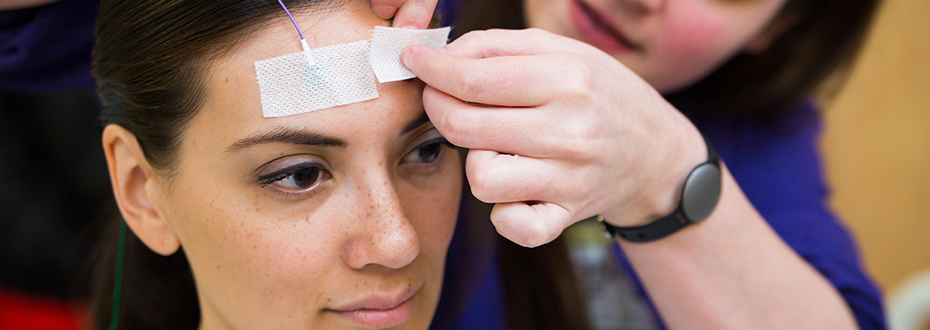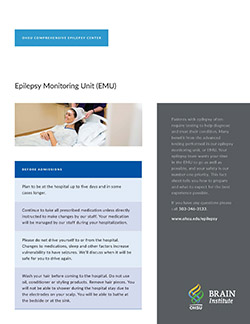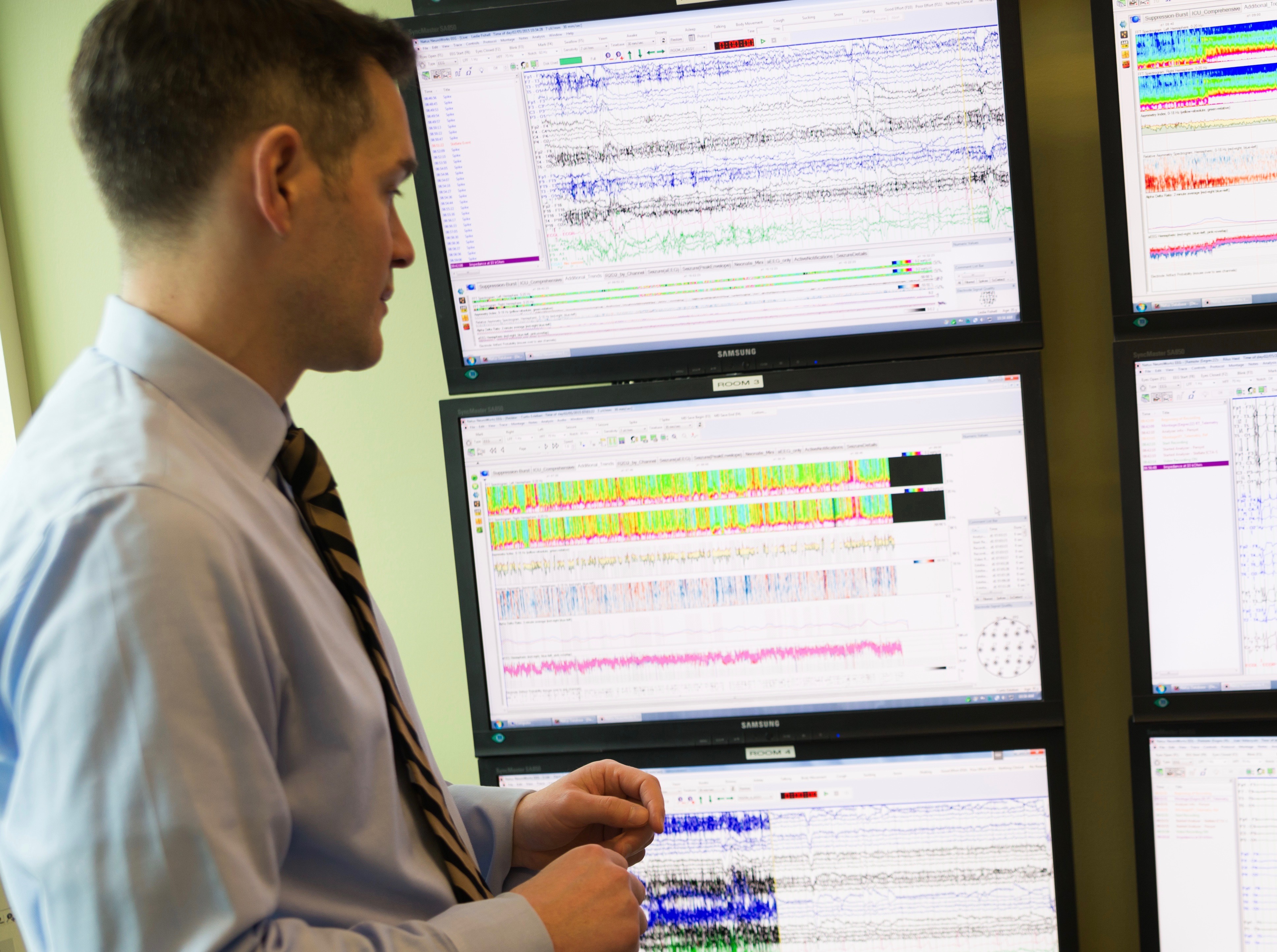Diagnosing Epilepsy

Specialists at the OHSU Comprehensive Epilepsy Center use the latest tools to find the cause of seizures and epilepsy. We offer you:
- Oregon’s only Level 4 epilepsy center, reflecting the highest level of care and expertise as designated by the National Association of Epilepsy Centers.
- One of Oregon’s few epilepsy monitoring units, to precisely map your seizures.
- The state’s only image-guided robotic procedure to pinpoint the source of seizures anywhere in the brain.
- Advanced brain imaging, including SPECT scans, to show where seizures start and to guide treatment.
- Team-based care, with a nurse navigator to answer your questions.
Only at OHSU
We are the only Oregon center with an advanced three-part system to diagnose and surgically treat complex epilepsy. This minimally invasive option combines robotic, MRI and laser technology for adults and children.
- Read more about our ROSA (robotic stereotactic assistance) and MRI services below.
- Read about the system’s benefits and how the three parts work together on our Epilepsy Treatment page.
First appointment
Many patients start with an appointment in our clinic. Others are referred by their neurologist directly to our epilepsy monitoring unit.
In either setting, we’ll talk with you about your medical history and symptoms. We will also review any previous tests and do a physical exam.
We may recommend more tests to:
- Confirm an epilepsy diagnosis
- Rule out other conditions
- Find where in your brain seizures start
Epilepsy monitoring unit (EMU)
Our epilepsy monitoring unit offers in-depth testing and monitoring for epilepsy that is difficult to diagnose or treat. OHSU has one of Oregon’s only EMUs, staffed by a team of epilepsy specialists.
Learn more about testing in our advanced epilepsy monitoring unit, designed for your safety and comfort.
What the EMU does
Our high-tech EMU enables us to monitor your seizures in a safe, controlled environment. A seizure-trained nurse is always available, and an epilepsy doctor provides daily updates.
The unit uses 24/7 video EEG (electroencephalogram) monitoring so we can see and record your brain’s electrical activity during a seizure. This testing can help us locate where in the brain seizures start so we can recommend an effective treatment plan. It also gives us a baseline so we can monitor changes, adjusting treatment as needed.
EMU features
- Eight private rooms: Inpatient beds enable us to provide monitoring as long as needed for high-quality results. Rooms include a bed for an adult guest who understands your seizures.
- Dedicated nurse navigator: Our nurse navigator keeps you and your family informed about resources and options.
- Specialized imaging: Brain scans provide detailed images to pinpoint where seizures start. We use these scans to plan precise epilepsy surgery. OHSU is the only center in Oregon that offers SPECT scanning to see blood flow during a seizure. (SPECT stands for single-photon emission computed tomography.)
- Advanced monitoring: We use EEG to measure the brain’s electrical activity. This helps us determine the type of seizures and epilepsy syndrome for better treatment planning. Learn more about types on our Understanding Epilepsy page.
Preparing for your stay

Before your stay at OHSU’s EMU, learn about:
- What to do beforehand
- What to bring
- What to do on the day of your arrival
- What to do during your stay
- What to do after your stay
- Information for your companion

EEG (electroencephalogram)
An EEG measures electrical activity in the brain, sometimes revealing where seizures begin.
Standard EEG
A technician attaches electrodes (flat, metal discs) to your scalp with adhesive. The electrodes send electrical signals from the brain to a computer, where your doctor can review the patterns.
- Ambulatory EEG: Because the brain’s electrical activity may appear normal between seizures, you may have an ambulatory EEG that you wear home. You may wear this portable device for up to two days to continuously record electrical activity.
Implanted EEG
More detailed testing can pinpoint a seizure’s exact location before surgery. Our neurosurgeons place electrodes on or in the brain to record electrical activity. Types include:
Subdural electrodes: The surgeon places disc electrodes on the surface of the brain through tiny openings in the skull. Subdural electrodes record electrical activity inside the brain more precisely than standard electrodes on the scalp do.
ROSA (robotic stereotactic assistance): OHSU is the only center in Oregon with this option.
- What it is: Neurosurgeons use a robot to place thin flexible wires called stereotaxic depth electrodes in the brain. This lets them record electrical activity in areas other electrodes can’t reach. This procedure is a form of stereotactic EEG, or SEEG.
- How it’s done: Neurosurgeons use GPS-like brain mapping and tiny incisions to place as many as 20 electrodes. This enables us to reach any part of the brain. We can identify where seizures start with pinpoint precision and in about half the time as the traditional method.
Imaging
We offer the most advanced imaging for both diagnosis and treatment. In Oregon, SPECT technology for studying seizures is available only at OHSU.
MRI scan: Magnetic resonance imaging uses radio waves and powerful magnets to produce detailed images of the brain.
PET scan: For positron emission tomography, we inject a small amount of radioactive material into a vein. The substance travels to the brain, where a special scanner can detect it. Seeing blood flow through the brain can help identify where focal seizures begin.
SPECT scan: If an EEG and MRI don’t show exactly where seizures start, we may recommend a scan called single-photon emission computerized tomography. Like in a PET scan, a small amount of radioactive material is injected. The SPECT scan can capture detailed 3D images of blood flow in the brain during a seizure, and not. Comparing the images helps us pinpoint where seizures start.
Other tests
Tests you may have as part of your diagnosis can include:
Neurologic exam: Your doctor checks brain function with tests such as:
- Questions to test memory and the ability to do simple math
- A short walk to evaluate muscle function
- Reflex tests
- Sensory tests
Blood tests: These can give information about infections, genetic indicators or other conditions related to seizures. We also check the blood levels of any seizure medications to fine-tune the dose and watch for side effects.
Spinal tap: Most people with epilepsy don't need this test. Doctors use this test, also called a lumbar puncture, to collect a sample of cerebrospinal fluid from your spinal column. Analyzing this clear liquid, which surrounds the brain and spinal cord, can help rule out infections as the cause of seizures. Doctors inject a numbing medicine into the lower spine, then use a needle to collect the sample.
For patients
- Referral: To become a patient, please ask your doctor for a referral.
- Questions: For questions or follow-up appointments, please call 503-494-7772.
- Epilepsy FAQ and resources
- OHSU care for children and teens with epilepsy
Location
Parking is free for patients and their visitors.
Mark O. Hatfield Research Center, 13th Floor
3250 S.W. Sam Jackson Park Road
Portland, OR 97239
Map and directions
Refer a patient
- Refer your patient to OHSU.
- Call 503-494-4567 to seek provider-to-provider advice.